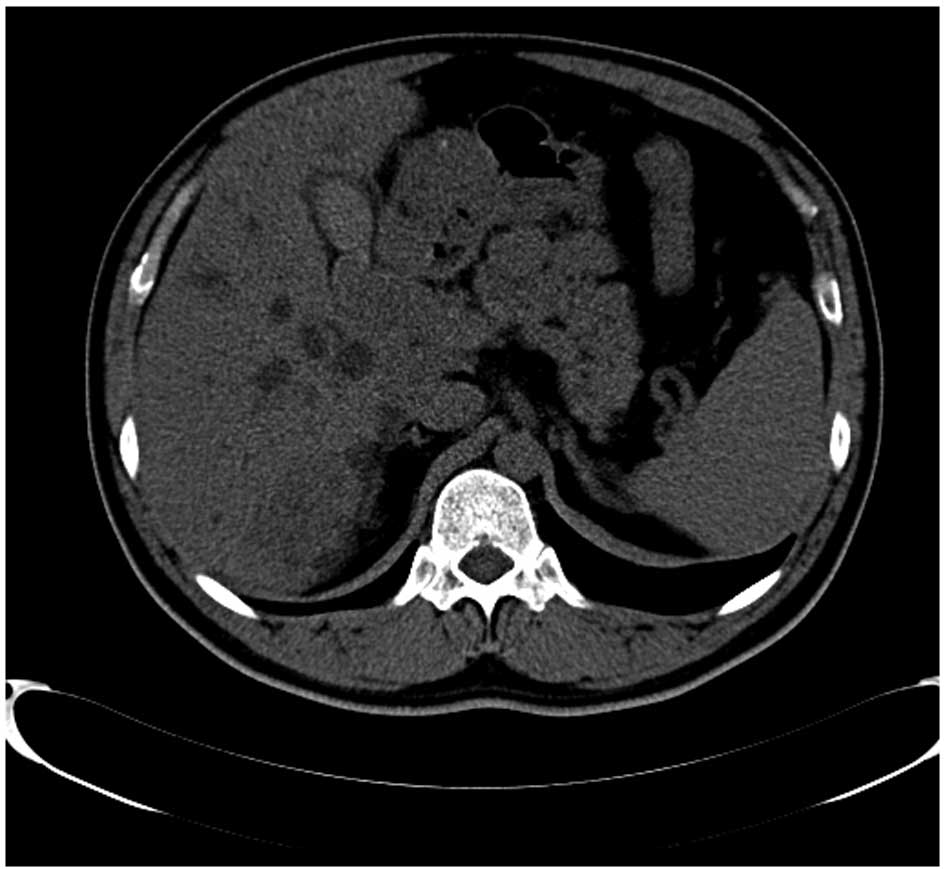|
1
|
Gerald WL and Rosai J: Case 2.
Desmoplastic small cell tumor with divergent differentiation.
Pediatr Pathol. 9:177–183. 1989. View Article : Google Scholar : PubMed/NCBI
|
|
2
|
Briseño-Hernández AA, Quezada-López DR,
Corona-Cobián LE, Castañeda-Chávez A, Duarte-Ojeda AT and
Macías-Amezcua MD: Intra-abdominal desmoplastic small round cell
tumour. Cir Cir. 83:243–248. 2015.(In Spanish). View Article : Google Scholar : PubMed/NCBI
|
|
3
|
Zhang WD, Li CX, Liu QY, Hu YY, Cao Y and
Huang JH: CT, MRI, and FDG-PET/CT imaging findings of
abdominopelvic desmoplastic small round cell tumors: Correlation
with histopathologic findings. Eur J Radiol. 80:269–273. 2011.
View Article : Google Scholar : PubMed/NCBI
|
|
4
|
Kis B, O'Regan KN, Agoston A, Javery O,
Jagannathan J and Ramaiya NH: Imaging of desmoplastic small round
cell tumor in adults. Br J Radiol. 85:187–192. 2012. View Article : Google Scholar : PubMed/NCBI
|
|
5
|
Mainenti PP, Romano L, Contegiacomo A,
Romano M, Casella V, Cuccuru A, Insabato L and Salvatore M: Rare
diffuse peritoneal malignant neoplasms: CT findings in two cases.
Abdom Imaging. 28:827–830. 2003. View Article : Google Scholar : PubMed/NCBI
|
|
6
|
Pickhardt PJ, Fisher AJ, Balfe DM, Dehner
LP and Huettner PC: Desmoplastic small round cell tumor of the
abdomen: Radiologic-histopathologic correlation. Radiology.
210:633–638. 1999. View Article : Google Scholar : PubMed/NCBI
|
|
7
|
Chouli M, Viala J, Dromain C, Fizazi K,
Duvillard P and Vanel D: Intra-abdominal desmoplastic small round
cell tumors: CT findings and clinicopathological correlations in 13
cases. Eur J Radiol. 54:438–442. 2005. View Article : Google Scholar : PubMed/NCBI
|
|
8
|
Kim HJ, Sohn BS, Kwon JE, Kim JY and Park
K: ThinPrep cytological findings of desmoplastic small round cell
tumor with extensive glandular differentiation: A case study.
Korean J Pathol. 47:182–187. 2013. View Article : Google Scholar : PubMed/NCBI
|
|
9
|
Dufresne A, Cassier P, Couraud L,
Marec-Bérard P, Meeus P, Alberti L and Blay JY: Desmoplastic small
round cell tumor: Current management and recent findings. Sarcoma.
2012:7149862012. View Article : Google Scholar : PubMed/NCBI
|
|
10
|
Ben-Sellem D, Liu KL, Cimarelli S,
Constantinesco A and Imperiale A: Desmoplastic small round cell
tumor: Impact of F-FDG PET induced treatment strategy in a patient
with long-term outcome. Rare Tumors. 1:e192009. View Article : Google Scholar : PubMed/NCBI
|
|
11
|
Nathan JD, Gingalewski C and Salem RR:
Intra-abdominal desmoplastic small round cell tumor. Yale J Biol
Med. 74:287–293. 1999.
|
|
12
|
Bellah R, Suzuki-Bordalo L, Brecher E,
Ginsberg JP, Maris J and Pawel BR: Desmoplastic small round cell
tumor in the abdomen and pelvis: Report of CT findings in 11
affected children and young adults. AJR Am J Roentgenol.
184:1910–1914. 2005. View Article : Google Scholar : PubMed/NCBI
|
|
13
|
Kim JH, Goo HW and Yoon CH:
Intra-abdominal desmoplastic small round-cell tumor: Multiphase CT
findings in two children. Pediatr Radiol. 33:418–421. 2003.
View Article : Google Scholar : PubMed/NCBI
|
|
14
|
Tateishi U, Hasegawa T, Kusumoto M, Oyama
T, Ishikawa H and Moriyama N: Desmoplastic small round cell tumor:
Imaging findings associated with clinicopathologic features. J
Comput Assist Tomogr. 26:579–583. 2002. View Article : Google Scholar : PubMed/NCBI
|
|
15
|
Gerald WL, Miller HK, Battifora H,
Miettinen M, Silva EG and Rosai J: Intra-abdominal desmoplastic
small round-cell tumor. Report of 19 cases of a distinctive type of
high-grade polyphenotypic malignancy affecting young individuals.
Am J Surg Pathol. 15:499–513. 1991. View Article : Google Scholar : PubMed/NCBI
|
|
16
|
Roberts P, Burchill SA, Beddow RA,
Wheeldon J, Cullinane C and Lewis IJ: A combined cytogenetic and
molecular approach to diagnosis in a case of desmoplastic small
round cell tumor with a complex translocation (11;22;21). Cancer
Genet Cytogenet. 108:19–25. 1999. View Article : Google Scholar : PubMed/NCBI
|
|
17
|
Gao DX, Liao SL, Shi XJ and Hui ZY:
Desmoplastic small round cell tumor: A report of 5 cases. Clin Exp
Pathol. 16:353–356. 2000.
|
|
18
|
Magnan H, Abramson SJ, Price AP, Grewal
RK, Merchant MS, LaQuaglia MP and Meyers PA: Positron emission
tomography for response assessment in desmoplastic small round cell
tumor. J Pediatr Hematol Oncol. 35:e190–e193. 2013. View Article : Google Scholar : PubMed/NCBI
|
|
19
|
Chung CJ, Bui V, Fordham LA, Hill J and
Bulas D: Malignant intraperitoneal neoplasms of childhood. Pediatr
Radiol. 28:317–321. 1998. View Article : Google Scholar : PubMed/NCBI
|
|
20
|
Haliloglu M, Hoffer FA and Fletcher BD:
Malignant peritoneal mesothelioma in two pediatric patients: MR
imaging findings. Pediatr Radiol. 30:251–255. 2000. View Article : Google Scholar : PubMed/NCBI
|
|
21
|
Johnson KA, Tung K, Mead G and Sweetenham
J: The imaging of Burkitt's and Burkitt-like lymphoma. Clin Radiol.
53:835–841. 1998. View Article : Google Scholar : PubMed/NCBI
|














